 |
Movie Reviews
Marie Antoinette: Her Myth and
An Attempt to Destroy It
Marie Antoinette reviewed by Atila S. Guimarães
France still has the charisma of being the firstborn of the Church. Its history, more than that of any other country, raises general interest, despite protests of resentful and unsuccessful competitors. Do you need evidence? Here is Marie Antoinette, the Queen par excellence, who returns to the focus of the present day discussion in our insipid democratic era.
In the last four years Marie Antoinette has been a constant high-ranking hit on the TIA website. From all over the world we constantly receive visitors who come just to read what we have on her. Recently readers have been insisting on a movie review of the film by director Sofia Coppola, with Kirsten Dunst as Queen Marie Antoinette and Jason Schwartzman, Coppola’s cousin, as King Louis XVI.
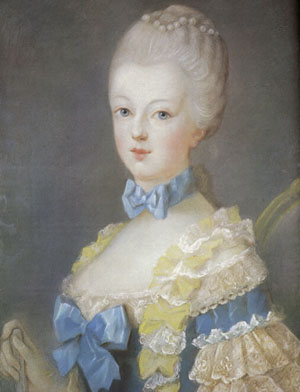
Marie Antoinette at age 14, when she married |
Some days ago I was driving through downtown Los Angeles, and I came upon three teen-age girls walking to high-school sporting an extravagant hairstyle in the shape of a large duck beak facing upward. I paid little mind to it, for today extravagance is the rule. Later, however, an association of images came to my mind: They were mimicking the hairstyle of the valets at Versailles pictured by Coppola in her film. Consciously or not, the girls were trying to be “in” imitating something from the Marie Antoinette era. It is still an indirect irradiation of her prestige.
I didn’t plan to watch this movie. I was invited by two ladies more to chauffeur them through a difficult traffic section than anything else. One of the ladies planned to write the solicited review. But since the movie was obsessively sex-centered with embarrassing allegations against King Louis XVI, she didn’t feel comfortable writing it. So I assumed the task.
For more than half of the two-hour film, attention is focused on a supposed physical defect of the young Louis XVI that would have caused the marriage not to be consummated in the first seven years. Historically speaking, the cause of this abstinence in the royal couple’s marriage is disputable. Some historians insist that only a physical handicap would explain it. Others, like Antonia Fraser in her book Marie Antoinette, The Journey – upon which Coppola pretends to have based the movie, opines otherwise. Fraser thinks the couple didn’t consummate the marriage because they were “two complete blunderers,” using the expression of Marie Antoinette’s brother, the future Emperor Joseph II of Austria. On a diplomatic visit to Versailles in April 1777, he took advantage of the opportunity to enquire what was going on at the request of his mother, Empress Maria Teresa. On this point, as so many others, Sofia Coppola does not follow the sources as she pretends.
It seems difficult for the modern man, saturated with Freudian pagan theories, to imagine the purity of two teenagers of the 18th century. When they married, he was 15 and she was 14, both having being raised in extremely good Catholic ambiences. One of Louis XVI’s aunts was a Blessed, who had a great influence over his customs. The Austrian court of Emperor Francis and Empress Maria Teresa was notoriously moral. At the time it was not rare for spouses, especially at this age, to agree to consummate the marriage some years later. This is what probably happened with the royal couple.
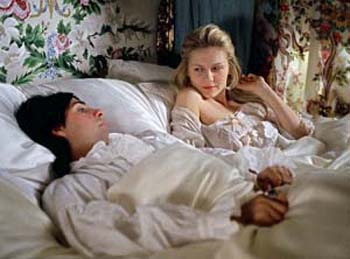
Obsessive intrusions into the royal bedroom
|
What would be the possible handicap of Louis XVI? Some try to explain the absence of conjugal relations as caused by a phimosis. This is a man’s problem, defined by Stedman’s Medical Dictionary as “a narrowness of the prepuce preventing its being drawn back over the glans.” The practical consequence is that the first time a man with this condition has conjugal relations, he experiences the pain equivalent to a circumcision. It is not so different from what a virgin bride experiences in the first conjugal act. I don’t think that any married woman fears this pain on her wedding night, nor would any man with that small problem. This is the modern allegation, even though I stress that it is not the most probable hypothesis.
Notwithstanding, Coppola makes this possible problem of Louis XVI the great issue of her movie. Bedroom scenes where a frustrated Marie Antoinette unsuccessfully tries to consummate the marriage are repeated over and over. Court rumors, street gossip among the people in Paris, international diplomats, all would have little else on their minds but the supposed phimosis of Louis XVI. It is definitely obsessive.
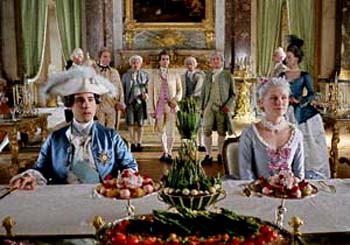
Ridiculing the ceremonial dining |
When finally, more than midway through, she is obliged to cursorily report that the royal couple had children, Coppola turns the movie to another sexual issue, a love affair of the Queen - also historically disputable. Count Axel von Fersen was certainly a frequent visitor at Versailles and had a friendship with the Queen, as did many other nobles. They exchanged letters about little questions as insignificant as the place to plant a new tree. In one of these letters, Marie Antoinette uses the expression “I love you,” which in that sentimental period had many meanings different from the perspective of an intimate relationship. As far as I know, no evidence of a love affair has ever been presented, and the witnesses closest to the Queen always defended her purity and high morals.
To refute this calumny I make a simple point: Marie Antoinette was a very Catholic lady. As such, her greatest concern would be to die in peace with God and save her soul. If, as alleged, she would have been having a love affair with Fersen until some months before she was imprisoned, she would have made reparation before her death, which at a certain point she foresaw as a certainty. Now then, even though we have many details about her life as a prisoner in the Temple and the Conciergerie, she exhibited no such anxiety to put her soul in order during that last year and a half of her life. On the eve of her execution, Marie Antoinette wrote a last letter to her sister-in-law Elisabeth, noting: “I am calm, as people are whose consciences are clear.”
She had such a great peace of conscience that when she was sent to the guillotine, she refused the confessor offered by the revolutionaries – one of those Catholic priests who had sworn to obey the Civil Constitution of the Clergy, one of the progressivists of the time.
Actually, she received the absolution of a counter-revolutionary Catholic priest who was disguised among the populace near the scaffold. It is not certain, however, whether she knew beforehand that a priest would be there. So, if she had any scandal in her life, she would have been anxiously seeking a confessor – even that priest who had taken the oath, since he could give a valid absolution. This didn’t happen.
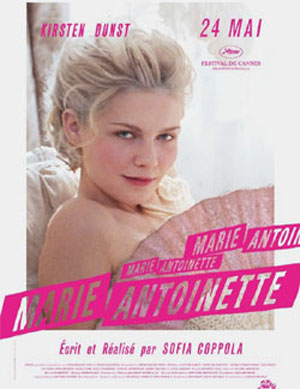
A picture from the love affair scene was used as the symbol of the film at the Cannes Festival |
Even with a never-proved affair, Sofia Coppola feels free to concoct a scorching pornographic scene where the actress representing Marie Antoinette is nude and receives the naked Fersen in her arms. As far as I know, the depiction is as obscene as a movie presented in public theaters can be.
The director also ridicules the lifestyle of the French Ancien Régime. For Coppola, the royal couple’s meals are too artificial, their daily dressing ceremony in the presence of nobles too exaggerated, the attendance of court dignitaries at the birth of the heir to the throne too inhumane. What Coppola expresses is how Hollywood sees the Ancien Régime.
To protest the ceremonious life that she didn’t like, she introduces some grotesque scenes: nobles at a ball dancing to rock’n’roll, the queen and ladies-of-honor using slang, Louis XV’s bawdy behavior with his mistress Du Barry where he acts like a drunk cowboy in a saloon, with a particularly grotesque bedroom scene. There is no concern about history in these depictions. Like a street urchin throwing mud on the windows of a house he cannot own, Coppola depicts the nobility of the Ancien Régime. A futile revolt, nothing else.
To please Hollywood, and perhaps to earn laurels for her film, she puts homosexuals in the movie, especially the hairdresser of Marie Antoinette and his swarm of servants. They could be part of a “Gay Parade.” Also the duck-beak hairstyle of many valets I mentioned earlier is a product of Coppola’s imagination, not a historical reality.
Is everything bad in the movie? Some scenes – especially exterior panoramas – reflect the grandeur of Versailles quite well. Is it a voluntary or involuntary tribute? I don’t know. The costumes are rich, brilliant and most of them well-reproduced. The hunt scenes are superb, the carriages and horses magnificent.
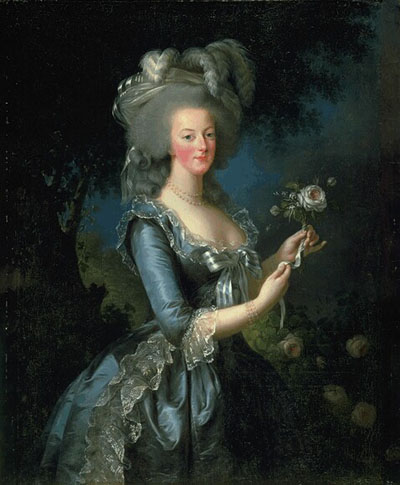
Artist Vigée-le-Brun pictures well the majestic myth that history maintains of Queen Marie Antoinette |
I read a dozen short reviews by French writers and journalists on this movie. Most of them protest the lack of historical precision. Others emphatically applaud the film, being sycophants of almost everything from Hollywood. It is the sad fate of decadent Europeans. They readily sell their honor. They don’t value their history and nobility unless it is mixed with cinema and money. There were some, whom I imagine sincere, who opined that Sofia Coppola tried to present Marie Antoinette in a good light. It took me a while to understand how this could be.
I am a Catholic and I try to analyze everything from the Catholic point of view. For this reason, since the Revolution is constantly increasing, there is a gap of understanding between myself and some of the younger generations. I had to think a bit to realize how such a movie could present Marie Antoinette in a good light.
I reached this conclusion: since the generation to which Sofia Coppola belongs is in the main moral-free, perhaps she was portraying Marie Antoinette as one of her set – with sexual obsessions and a lover – because she thinks this makes the Queen palatable to her peers. So, she may not have intended to do the evil that she did with this movie. I am giving her that benefit of the doubt. But I stress that I am not judging intentions here. I am just analyzing the movie as it is.
Like so many other calumnies or misinterpretations, sooner or later this movie will fall into oblivion. What will remain is the prestige of Marie Antoinette that continues to grow. This film is a conscious or unconscious attempt to obscure the myth of that great Catholic Queen. I don’t think it will succeed. Marie Antoinette will continue to swim in the lake of History as the majestic swan that she was. No louse on the neck of this elegant swan will stain its glory.

Posted on December 12, 2006

Related Topics of Interest
 Louise of France and Her Counter-Revolutionary Action Louise of France and Her Counter-Revolutionary Action
 Unmasking the Formidable Myth about Queen Marie Antoinette Unmasking the Formidable Myth about Queen Marie Antoinette
 Nobility and Accessibility: Keys of Catholic Charity Nobility Nobility and Accessibility: Keys of Catholic Charity Nobility
 Madame Royale and the End of the Age of Innocence Madame Royale and the End of the Age of Innocence
 Evita: A False Portrayal of the Revolutionary South American Masses Evita: A False Portrayal of the Revolutionary South American Masses
 The Messenger: A Distorted View of the Maid of Orleans The Messenger: A Distorted View of the Maid of Orleans
 Revolution and Counter-Revolution - Overview Revolution and Counter-Revolution - Overview

|
Movie Reviews
| Home | Books |
CDs | Search |
Contact Us

© 2002-
Tradition in Action, Inc. All Rights Reserved
|
 |
|